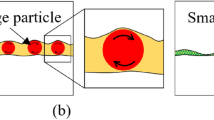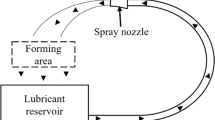Abstract
The formation of persistent residues by esters used in sheet metal-working lubricant formulations interferes with metal surface cleanliness and impairs the integrity of subsequent surface coatings. Understanding the thermal decomposition and residue formation properties of esters is therefore crucial to minimising residue formation during furnace-based cleaning and will aid in the improvement of coated metal products such as galvanised steel. The thermo-oxidative decomposition profiles of four different methyl esters were studied by Thermogravimetric Analysis (TGA) and Pressure Differential Scanning Calorimetry (PDSC). Chemical characterisation of residues remaining at different stages during the thermo-oxidative decomposition process was achieved by infrared spectroscopic analysis of TGA residue samples. Relationships between ester alkyl chain unsaturation levels and the amount/chemical nature of residue present at high temperature (500 °C) were assessed. In the presence of oxygen, polyunsaturated esters decomposed to leave significantly greater amounts of thermally-stable residue, comprising of metal carboxylate and non-volatile oxygenated compounds, than more saturated esters. Given that the formation of analogous residues by more complex esters used in sheet metal-working lubricants may give rise to metal surface coating defects, the results of this study suggest that polyunsaturated esters should be avoided in lubricant formulations where preventing residue formation is of paramount importance.








Similar content being viewed by others
References
Coni E, Podesta E, Catone T (2004) Oxidizability of different vegetable oils evaluated by thermogravimetric analysis. Thermochim Acta 418:11–15
Hasenhuettl GL (2005) Fats and Fatty Oils. In: Kroschwitz JI (ed) Kirk-Othmer Encyclopedia of Chemical Technology. John Wiley, New York, pp 801–836
Dweck J, Sampaio CMS (2004) Analysis of the thermal decomposition of commercial vegetable oils in air by simultaneous TGA/DTA. J Therm Anal Cal 75:385–391
Santos JCO, Santos IMG, Conceicao MM, Porto SL, Trindade MFS, Souza AG, Prasad S, Fernandes VJ, Araujo AS (2004) Thermoanalytical, kinetic and rheological parameters of commercial edible vegetable oils. J Therm Anal Cal 75:419–428
Oyman ZO, Ming W, van der Linde R (2005) Oxidation of drying oils containing non-conjugated and conjugated double bonds catalysed by a cobalt catalyst. Prog Org Coat 54:98–204
Zhang Y, Perez JM, Pei P, Hsu SM (1992) Deposit forming tendencies of diesel engine oils - correlation between the two-peak method and engine tests. Lubr Eng 48:221–226
Zhang Y, Pei P, Perez JM, Hsu SM (1992) A new method to evaluate deposit-forming tendency of liquid lubricants by differential scanning calorimetry. Lubr Eng 48:189–195
Santos JCO, Santos IMG, Souza AG, Sobrinho EV, Fernandes VJ Jr, Silva AJN (2004) Thermoanalytical and rheological characterization of automotive mineral lubricants after thermal degradation. Fuel 83:2393–2399
Gamlin CD, Dutta NK, Choudhury NR, Kehoe D, Matisons J (2002) Evaluation of kinetic parameters of thermal and oxidative decomposition of base oils by conventional, isothermal and modulated TGA and pressure DSC. Thermochim Acta 392–292:357–369
Senthivel R, Joseph M, Nagar SC, Kumar A, Naithani KR, Mehta AK, Raje NR (2005) An investigation into the thermal behaviour of lubricating greases by diverse techniques. NLGI Spokesman 69:26–36
Kauffman RE, Rhine WE (1988) Development of a remaining useful life of a lubricant evaluation technique Part I: differential scanning calorimetric techniques. Lubr Eng 44:154–161
Sharma BK, Stipanovic AJ (2003) Development of new oxidative stability test method for lubricating oils using high-pressure differential scanning calorimetry. Thermochim Acta 402:1–18
Keyser AG, Kunkel KF, Snedaker LA (1998) Impact of rolling emulsion contaminants on downstream surface quality. Iron Steel Eng 75:43–46
Osten-Sacken J, Pompe R, Skold R (1985) Thermoanalytical study of water-based aluminium rolling fluids combined with direct observation. Thermochim Acta 95:431–434
Litwinienko G, Daniluk A, Kasprzycka-Guttman T (1999) A differential scanning calorimetry study on the oxidation of C12–C18 saturated fatty acids and their esters. J Am Oil Chem Soc 76:655–657
Adhvaryu A, Erhan SZ, Liu ZS, Perez JM (2000) Oxidation kinetic studies of oils derived from unmodified and genetically modified vegetables using pressurized differential scanning calorimetry and nuclear magnetic resonance spectroscopy. Thermochim Acta 364:87–97
Dunn R (2006) Oxidative stability of biodiesel by dynamic mode pressurized-differential scanning calorimetry (P-DSC). Trans ASABE 49:1633–1641
Dunn R (2000) Analysis of oxidative stability of methyl soyate by pressurized-differential scanning calorimetry. Trans ASAE 43:1203–1208
Dunn R (2002) Effect of oxidation under accelerated conditions on fuel properties of methyl soyate (biodiesel). J Am Oil Chem Soc 79:915–919
Porter NA, Mills KA, Carter RL (1994) A mechanistic study of oleate autooxidation: competing peroxyl H-atom abstraction and rearrangement. J Am Chem Soc 116:6690–6696
Frankel EN (1985) Chemistry of free radical and singlet oxidation of lipids. Prog Lipid Res 23:197–221
Cheenkachorn K, Lloyd WA, Perez JM (2003) The use of pressurized differential scanning calorimetry (PDSC) to evaluate effectiveness of additives in vegetable oil lubricants. In: ASME ICES03, Spring Technical Conference Internal Combustion Engine Division. ASME, Saltzburg, pp 197–206
Sathivel S, Prinyawiwatkul W, Negulescu I, King J, Basnayake B (2003) Thermal degradation of FA and catfish and menhaden oil at different refining steps. J Am Oil Chem Soc 80:1131–1134
van Aardt M, Duncan SE, Long TE, O’Keefe SF, Marcy JE, Sims SR (2004) Effect of antioxidants on oxidative stability of edible fats and oils: thermogravimetric analysis. J Agric Food Chem 52:587–591
Dunn RO (2005) Effect of antioixdants on the oxidative stability of methyl soyate (biodiesel). Fuel Proc Technol 86:1071–1085
Shen L, Alexander KS (1999) A thermal analysis study of long chain fatty acids. Thermochim Acta 340–341:271–278
Litwinienko G, Daniluk A, Kasprzycka-Guttman T (2000) Study on autooxidation kinetics of fats by differential scanning calorimetry. 1. Saturated C-C fatty acids and their esters. Ind Eng Chem Res 39:7–12
Litwinienko G, Kasprzycka-Guttman T (2000) Study on the autooxidation kinetics of fat components by differential scanning calorimetry. 2. Unsaturated fatty acids and their esters. Ind Eng Chem Res 39:13–17
Dufaure C, Thamrin U, Mouloungui Z (1999) Comparison of the thermal behaviour of some fatty esters and related ethers by TGA-DTA analysis. Thermochim Acta 338:77–83
Abou El Naga HH, Salem AEM (1984) Effect of worn metals on the oxidation of lubricating oils. Wear 96:267–283
Gracia-Fernandez CA, Gomez-Barriero S, Ruiz-Salvador S, Blaine R (2005) Study of the degradation of a thermoset system using TGA and modulated TGA. Prog Org Coat 54:332–336
Williams DH, Fleming I (1997) Spectroscopic Methods in Organic Chemistry. McGraw-Hill, Berkshire
Acknowledgments
The authors would like to thank the Australian Research Council (ARC) for supporting this work through its Linkage Projects funding scheme (project number LP0347847). Thanks also go to Quaker Chemical and BlueScope Steel® for their financial contribution to this project and for sharing their practical and research experience in this area.
Author information
Authors and Affiliations
Corresponding author
About this article
Cite this article
Pillar, R., Ginic-Markovic, M., Clarke, S. et al. Effect of Alkyl Chain Unsaturation on Methyl Ester Thermo-Oxidative Decomposition and Residue Formation. J Am Oil Chem Soc 86, 363–373 (2009). https://doi.org/10.1007/s11746-009-1358-7
Received:
Revised:
Accepted:
Published:
Issue Date:
DOI: https://doi.org/10.1007/s11746-009-1358-7




